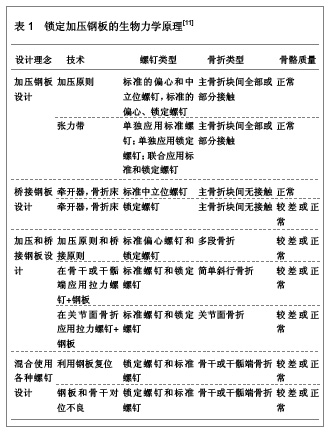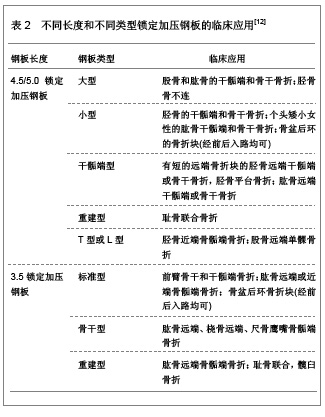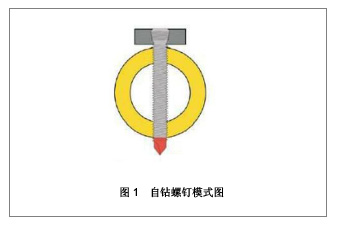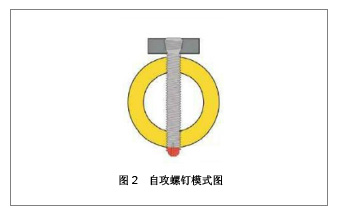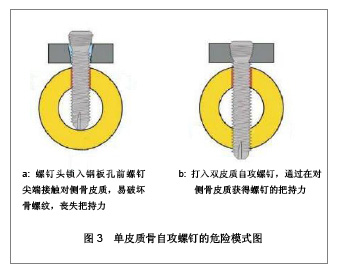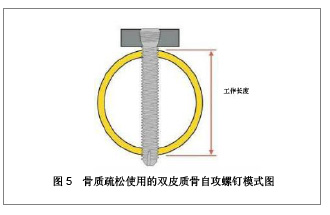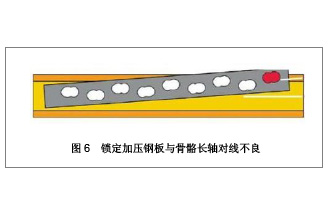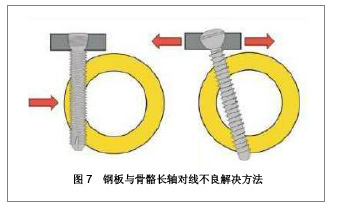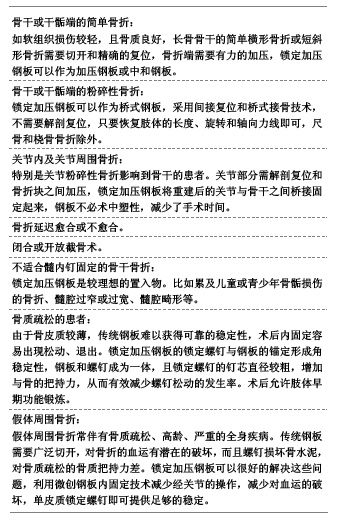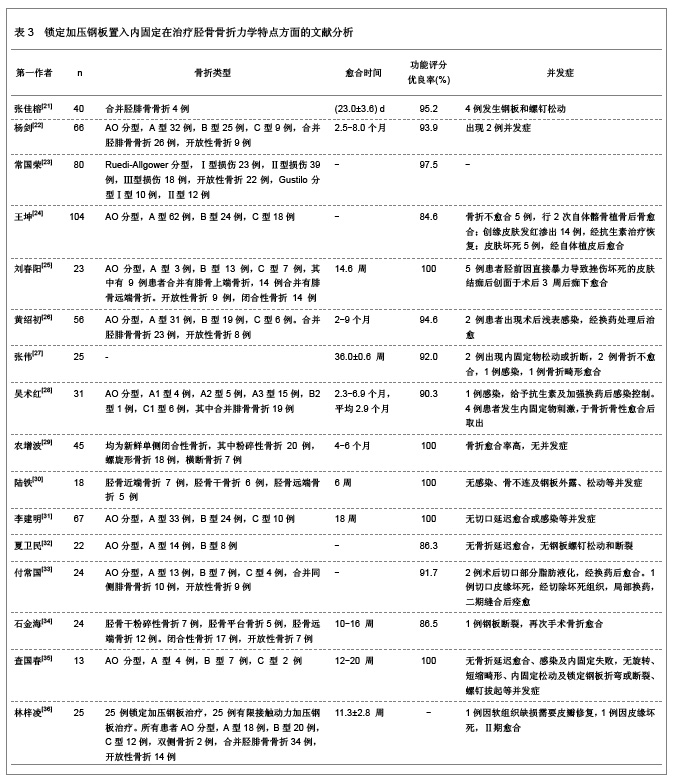| [1] Chakravarthy J, Bansal R, Cooper J. Locking plate osteosynthesis for Vancouver Type B1 and Type C periprosthetic fractures of femur: a report on 12 patients. Injury.2007;38(6):725-733.[2] Leung F, Chow SP. Locking compression plate in the treatment of forearm fractures: a prospective study. J Orthop Surp(Hong Kong).2006;14(3):291-294.[3] Miller DL, Goswami T. A review of locking compression plate biomechanics and their advantages as internal fixators in fracture healing. Clin Biomech(Bristol,Avon).2007;22(10):1049-1062.[4] Phisitkul P, McKinley To, Nepola JV, et al. Complications of locking plate fixation in complex proximal tibia injuries. J Orthop Trauma.2007;21(2):83-91.[5] Arora R, Lutz M, Hennerbichler A, et al. Complications following in-ternal fixation of unstable distal radius fracture with a palmar locking plate. J Orthop Trauma.2007;21(5): 316-322.[6] Chung KC, Watt AJ, Kotsis SV. Treatment of unstable distal radial fractures with the volar locking plate system. J Bone Joint Surg(Am).2006;88(12):2687-2694.[7] Rose PS, Adams CR, Torchia ME, et al. Locking plate fixation for proximal humeral fractures: initial results with a new implant. J Shoulder Elbow Surg. 2007;16(2):202-207.[8] Gautier E, Sommer C. Guidelines for the clinical application of the LCP. Injury.2003;34(2Suppl):63-76.[9] Sommer C, Babst R, Mvller M, et al. Locking compression plate loos-ening and plate breakage: a report of four cases. J Orthop Trau-ma.2004;18(8):571-577.[10] Kregor PJ, Stanard JA, Zlowodzki M, et al. Treatment of distal femur fractures using the less invasie stabilization system: surgical experience and early clinical results in 103 fractures. J Orthop Trauma.2004;18(8):509-520.[11] 丁香园. 锁定加压钢板临床应用指南(一)[DB/OL].2012-12-15. http://orthop.dxy.cn/article/10527[12] 曹清,马宝通.锁定加压钢板的临床应用[J].中国矫形外科杂志, 2008,16(12):930-931.[13] 周凤彬,潘梁.锁定加压钢板在多发性骨折中的应用[J].中外医疗,2011,30(13):44,46.[14] 刘晓辉,张国川.锁定加压钢板生物力学原理及置入后的失败分析[J].中国组织工程研究与临床康复,2011,15(4):717-720.[15] 邓仁椿,洪澜,崔华明,等.经皮微创锁定加压钢板内固定治疗胫骨远段骨折[J].中国矫形外科杂志,2010,18(8):682-684.[16] 张飞,武宇赤,李哲海,等.锁定加压钢板内固定失败原因分析[J]. 实用骨科杂志,2012,18(2):177-180.[17] 丁华文,尹生云.锁定加压钢板治疗胫骨骨折的临床观察[J].求医问药,2012,10(2):557-558.[18] 丁香园. 锁定加压钢板临床应用指南(二)[DB/OL].2012-12-15. http://orthop.dxy.cn/article/10528_2[19] 龙雨.锁定加压钢板的临床应用[J].右江民族医学院学报,2010, 25(2):243-244.[20] 中国知网.国学术期刊总库[DB/OL].2012-08-10. https://www.cnki.net[21] 张佳榕.锁定加压钢板在治疗四肢骨折中的临床价值研究[J].临床医学工程,2012,19(9):1532-1533. [22] 杨剑.锁定加压钢板治疗胫骨骨折66例临床观察[J].亚太传统医药,2012,8(9):134-135. [23] 常国荣.锁定加压钢板治疗80例胫骨骨折的疗效观察[J].经验体会,2012,10(19):118. [24] 王坤,刘德昌.微创经皮和有限切开复位锁定加压钢板治疗胫骨骨折的疗效比较[J].中国临床医学,2012,19(3):270-271. [25] 刘春阳.经皮微创锁定加压钢板治疗胫骨远端骨折[J].医药论坛杂志,2011,32(19):136-137. [26] 黄绍初,李雄,曹粉红.锁定加压钢板治疗胫骨骨折的临床分析[J].临床医学工程,2011,18(9):1396-1397. [27] 张伟,王伟,林忠勤,等.解剖型胫骨髓内钉与锁定加压钢板内固定治疗胫骨骨折不愈合的疗效比较[J].中国骨与关节损伤杂志, 2011, 26(7):633-634. [28] 吴术红,刘毅.经皮微创锁定加压钢板内固定治疗胫骨远端骨折[J].医学理论与实验,2011,24(12):1429-1431. [29] 农增波,赵利敏,赵茂盛,等.经皮微创锁定加压钢板治疗胫骨骨折45例分析[J].中国误诊学杂志,2011,11(9):2212. [30] 陆铁,周君琳,刘清和,等.锁定加压钢板微创经皮内固定治疗胫骨骨折[J].中国骨与关节损伤杂志,2011,26(2):161-162. [31] 李建明,付新民,韩丽.有限切开复位锁定加压钢板治疗胫骨骨折67例分析[J].中国误诊学杂志,2011,11(4):938. [32] 夏卫民,阮腊林,黄林.有限切开结合锁定加压钢板固定治疗胫骨远端骨折[J].内蒙古中医药,2009,28(24):72-73. [33] 付常国,刘国华,宋自昌.锁定加压钢板治疗胫骨远端骨折[J].实用骨科杂志,2009,15(4):298-300. [34] 石金海,刘家瑞,蔡新良,等.锁定加压钢板内固定治疗胫骨骨折的疗效[J].实用临床医学,2008,9(12):52-54. [35] 查国春,陈泽林,齐小波.经皮微创锁定加压钢板内固定治疗胫骨骨折[J].中国修复重建外科杂志,2008,22(12):1448-1450. [36] 林梓凌,黄枫,郑晓辉,等.锁定加压钢板在胫骨干骨折治疗中的应用研究和探讨[J].中国中医骨伤科杂志,2006,14(5):1-3.[37] Ahmad M, Nanda R, Bajwa AS, et al.Biomechanical testing of the locking compression plate: when does the distance between bone and implant significantly reduce construct stability?Injury. 2007; 38(3):358-364.[38] Sommer C, Gautier E, Müller M, et al.First clinical results of the Locking Compression Plate (LCP).Injury. 2003;34 Suppl 2: B43-54.[39] Kääb MJ, Frenk A, Schmeling A,et al.Locked internal fixator: sensitivity of screw/plate stability to the correct insertion angle of the screw.J Orthop Trauma. 2004;18(8):483-487.[40] 彭朝华,杨彬,邹秋富,等.微创锁定加压钢板固定术中失误及术后早期并发症分析[J].四川医学,2012,33(6):965-967.[41] 张富军,杨昊,李靖,等.微创经皮钢板固定技术前置锁定加压钢板治疗肱骨中下段骨折[J]. 中国临床研究,2011,24(10):879-881.[42] Namazi H, Mozaffarian K.Awful considerations with LCP instrumentation: a new pitfall.Arch Orthop Trauma Surg. 2007; 127(7):573-575.[43] Hasenboehler E, Rikli D, Babst R.Locking compression plate with minimally invasive plate osteosynthesis in diaphyseal and distal tibial fracture: a retrospective study of 32 patients. Injury. 2007;38(3):365-370.[44] Smith WR, Ziran BH, Anglen JO, et al. Locking plates: tips and tricks. J Bone Joint Surg Am. 2007;89(10):2298-2307.[45] Ehlinger M, Adam P, Simon P, et al.Technical difficulties in hardware removal in titanium compression plates with locking screws.Orthop Traumatol Surg Res. 2009;95(5):373-376. |
